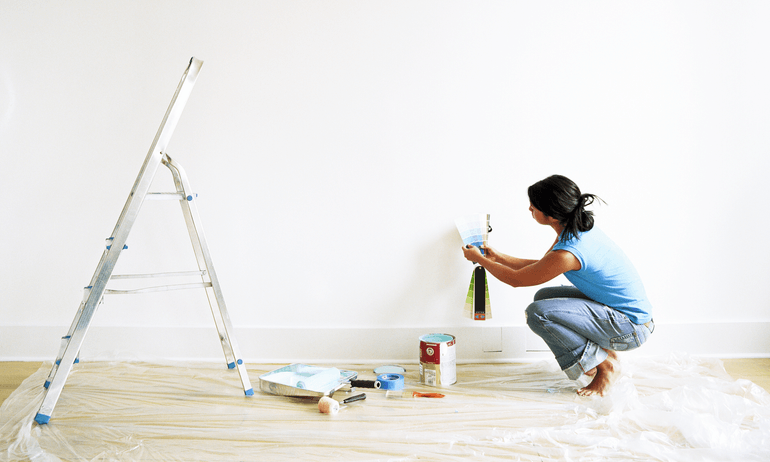2020 Home Improvement Report
NerdWallet analysis finds homeowners eager to spend money on home improvements but cautious amid pandemic concerns.

Some or all of the mortgage lenders featured on our site are advertising partners of NerdWallet, but this does not influence our evaluations, lender star ratings or the order in which lenders are listed on the page. Our opinions are our own. Here is a list of our partners.
Certainties in life: death, taxes and if you’re a homeowner, home repair and improvement projects. Even if you don’t plan for these projects, they come looking for you anyway, in the form of a leaky roof, flooded basement or other can’t-wait tasks.
Homeowners spent $522 billion on home improvements from 2017 to 2019, taking on an estimated 115 million projects, according to newly released data from the U.S. Census Bureau’s American Housing Survey. That’s a $72 billion increase in spending compared with the previous two-year period.
And since that census survey period, homeowners have taken on millions more projects, and likely many more than in a typical year, as the world was staying home to slow the spread of the coronavirus in 2020. In fact, as of mid-August, 61% of U.S. homeowners had taken on home improvement projects since March 1, according to a NerdWallet survey conducted online by The Harris Poll.
“The pandemic probably generated a lot of repair and rehab projects, for a couple of reasons,” says NerdWallet’s home and mortgage expert Holden Lewis. “First, homeowners were present to supervise the work or do it themselves. Second, people seized the chance to fix up their homes before listing them, preceding skyrocketing home sales in late summer.”
We analyzed findings from the American Housing Survey and two nationally representative NerdWallet surveys of more than 1,400 homeowners conducted online by The Harris Poll in August and September. With this perspective, we get a more holistic picture of homeowners’ recent, current and upcoming approaches to handling projects around the house.
Key findings
Home improvement spending is up. American homeowners spent $522 billion on home improvements from 2017 to 2019, according to census data, an increase of $72 billion compared with the previous two-year period. Typical spending per project also rose from $1,350 to $1,500.
Homeowners are making improvements during the pandemic but reluctant to hire professionals. About 3 in 5 homeowners (61%) have taken on home improvement projects since March 1, according to the August NerdWallet survey. When we asked in September, however, more than half (53%) of homeowners wouldn’t allow home repair or improvement professionals in their home due to safety concerns about the coronavirus.
Many homeowners are well prepared to pay for home improvements. Four-fifths (80%) of homeowners typically stick to the budget they set for home repair/improvement projects, and 75% have money set aside for this purpose, according to the September survey.
Do-it-yourself projects are still the minority. Homeowners DIY 37% of their projects, according to NerdWallet analysis of census data, which is roughly on a par with the number reporting DIY projects (38%) two years ago in our 2018 Home Improvement Report. The data indicates these DIY projects are lower-cost, likely not only because homeowners save money on labor costs, but also because homeowners are more likely to DIY less expensive projects overall.
Home improvements amid a global pandemic
More time at home in 2020 has meant more time for home improvements. About 3 in 5 homeowners (61%) have done home improvement projects since March 1, 2020, according to the August NerdWallet survey. Those homeowners spent $6,438, on average, on those projects.
Roughly a third (34%) of homeowners who did home improvement projects within the past two years say they took them on because they were spending more time at home due to pandemic-related social distancing measures, the September NerdWallet survey found.
The pandemic has also changed how homeowners feel about having contractors in their home. More than half (53%) say they wouldn’t allow home repair/improvement professionals in their home due to safety concerns about the coronavirus, according to the September survey. And more than three-fourths (79%) say if a home improvement professional had to enter their home, they’d be more cautious than usual due to safety concerns about the coronavirus.
Handy homeowner tip: Communicate any household safety measures before contractors come to your home. Set their expectations about mask-wearing and cleanliness as you would set their expectations about the scope of the project you’re asking them to do.
Paying for home improvements
Home repair and improvement projects can wind up being much more expensive than initially anticipated — finding out your plumbing leak has resulted in a rotten subfloor or your shingles were hiding shoddy repair work, for example. But according to the September NerdWallet survey, 80% of homeowners say they typically stick to the budget they set for such projects, compared with 76% when we asked in 2018.
Sticking to a home improvement budget means accurately estimating a project’s cost in the first place and adding a 10%-20% buffer for unexpected surprises that result in cost overages. This home improvement project estimator reveals median costs for a variety of projects in the American Housing Survey. From there, homeowners have to determine how they’ll pay for the project.
Three-fourths (75%) of homeowners say they have money set aside for home repairs/improvements, according to the September survey, compared with 69% when we asked in 2018. And while 52% of homeowners who have done projects in the past two years say they were “easily able to pay for the majority of them without tapping into savings, going into debt, or making sacrifices,” that leaves about half who were not.
Thankfully, there are numerous financing options available. According to the American Housing Survey, cash from savings covers the majority of projects, but more expensive projects are paid for with sources like cash-out refinancing, home equity loans, contractor arranged financing and even credit cards. “Something else,” the survey response chosen for 6% of projects, likely refers to personal loans, borrowing money from friends or family, and government grants available for home improvement projects.
Handy homeowner tip: If you have to finance a home improvement project, explore your options carefully. The right choice will depend on a variety of factors including how much your project will cost, how long it will take you to pay for it, your available home equity and your financial situation. A home improvement financing calculator can help you weigh the costs of options such as home equity loans and lines of credit, personal loans, refinancing your mortgage, and credit cards.
Doing it themselves
Homeowners DIY 37% of home improvement projects and hire professionals for 63%, according to NerdWallet analysis of census data. There are many reasons for taking on home repairs and improvements yourself. This year, the coronavirus pandemic is just one. Cost is another. Despite accounting for more than one-third of projects, DIY projects make up only 17% of total home improvement spending, indicating these are lower-cost projects.
Indeed, more than 1 in 5 (22%) homeowners who have done projects within the past two years took on DIY projects because they couldn’t afford to hire a professional, according to the September NerdWallet survey.
The typical project cost now stands at about $1,500, according to census data, but the typical DIY project cost is $600. While it’s true that doing the work yourself can save you money, it’s also true that homeowners are more likely to DIY less complicated — and therefore lower-cost — projects.
“Stay-at-home orders gave people time to watch HGTV and YouTube, where home repairs and renovations look doable,” Lewis says. “That might have led homeowners to tackle projects that they ordinarily would leave to experts.”
Handy homeowner tip: If you’re new to DIYing home repairs and improvements, start with simple projects such as painting, landscaping and swapping out light fixtures. These are relatively easy to do — and to fix. The cost of hiring a professional to fix a DIY project gone bad can far outweigh the money you’ll potentially save by not hiring a professional in the first place.
Home improvements in years to come
Most homeowners are well aware that some project or repair is bound to come up in the next few years, but an optimistic 7% of homeowners say they expect to spend no money on home repairs and improvements in the next two years, according to the September NerdWallet survey. On average, homeowners expect to spend $6,251 on home repairs and improvements in the next two years, with 1 in 5 (20%) anticipating $10,000 or more.
When asked how they’ll pay for these upcoming projects, homeowners seemed to prioritize using cash — that is, cash they have on hand (34%), money they plan on saving specifically for these projects (40%), or other savings (21%). More than 1 in 10 (11%) say they’ll use money they’ve saved from their economic stimulus check, though it isn’t clear if they’re referring to the money issued earlier this summer or if they’re hoping to have additional funds from a second stimulus check by the time they take on these projects.
One-fourth (25%) will use a credit card, which may make sense if they plan to reap credit card rewards and pay off the balance before interest negates those benefits.
Handy homeowner tip: The further ahead you can plan and save for home improvement projects, the better. But not all projects can be anticipated — plumbing leaks or an HVAC system on the fritz, for example, may happen without warning. Padding your household emergency fund can insulate you from at least some of these unexpected home repairs. If saving three to six months of living expenses — a good goal — seems too lofty, aim for $500 and build from there.
When asked what’s motivating their upcoming home improvements, 54% of homeowners considering projects in the next two years said they want to make their home more comfortable.
“One thing we can take away from 2020 is that our home is our refuge,” Lewis says. “Sometimes the best return on investment is comfort in the place where we spend most of our time.”
These surveys were conducted online within the United States by The Harris Poll on behalf of NerdWallet from Aug. 18-20, 2020, among 1,414 homeowners and Sept. 8-10, 2020, among 1,413 homeowners. These online surveys are not based on a probability sample and therefore no estimate of theoretical sampling error can be calculated. For complete survey methodology, including weighting variables and subgroup sample sizes, please contact Anna Palagi at [email protected].
The American Housing Survey is released every two years. For the latest release, interviews took place between June and November 2019 and homeowners were asked about the home improvement projects done on their home “in the past two years.” Respondents could have interpreted that to mean since January 2017, or since mid-2017.
The AHS asks homeowners to self-report what they spent on projects in a variety of categories. Beyond defining what constitutes a remodel versus a renovation, the survey does not break out projects by scale, scope, quality of materials or finish.
AHS data used in this report is specific to owner-occupied households.
The AHS measures project expenditures. For the purposes of this analysis, project “costs” and “expenditures” are used interchangeably.





